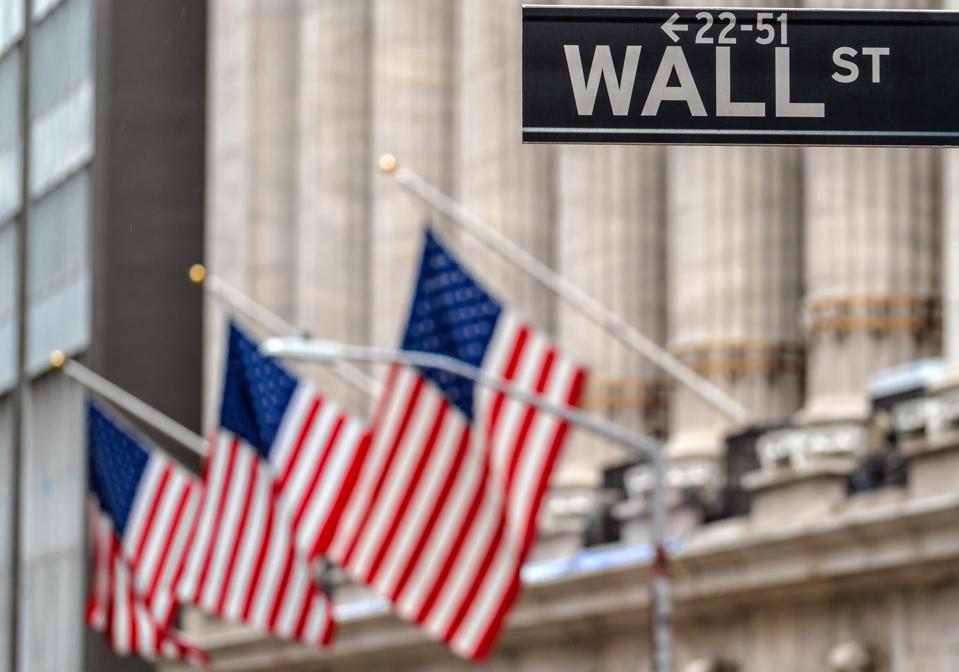
A recent article in the Washington Post literally struck home for me.
“Two Kens” are featured in an article on the front page of the May 5, 2021 Washington Post: How two Black CEOs got corporate America to pay attention to voting rights. The article notes in in passing that one of them, Ken Chenault, who was CEO of American Express for 17 – yes, that’s SEVENTEEN – years, “grew up in a middle-class Long Island neighborhood, the son of a dentist and a dental hygienist.”
Well, I grew up in the same neighborhood, sat on the bench as a freshman when Ken was a junior and a starter on the Waldorf School of Garden City basketball team, and idolized both him and his brother, Stephan, who was a year ahead of me and who gleefully jumped on my back when I was playing a pirate and he a policeman in the second act of a memorable (for me) production of Gilbert and Sullivan’s “Pirates of Penzance.”

Ken Chenault, #13; Stephan Chenault, #4 (photo obscured); the author, #20
Ken and his brother were not, like too many African Americans, recruited by my private school in mostly white Garden City, for their basketball prowess. We lived in nearby Hempstead, where I was part of the white minority and went to an old Methodist church that was similar in complexion. It wasn’t until many years later that I found out that the AME church less than a block away had finally absorbed my old church after the white congregation’s numbers dwindled because members fled to the suburbs. As a young boy, I was clueless about this stark racial divide.
My parents wanted me to go to a private school rather than be the only white kid in the nearby elementary school now named Barack Obama Elementary. Subsumed like so many African American boys in a majority white school setting, however, Ken and his two brothers went on to negotiate the perils of American capitalism. The rest, as they say, is history.
So whatever your religious or political affiliation, I can tell you from personal experience that when someone like Ken Chenault speaks, please listen with an open mind. As for me, I’m still sitting on the bench in awe of the starters.
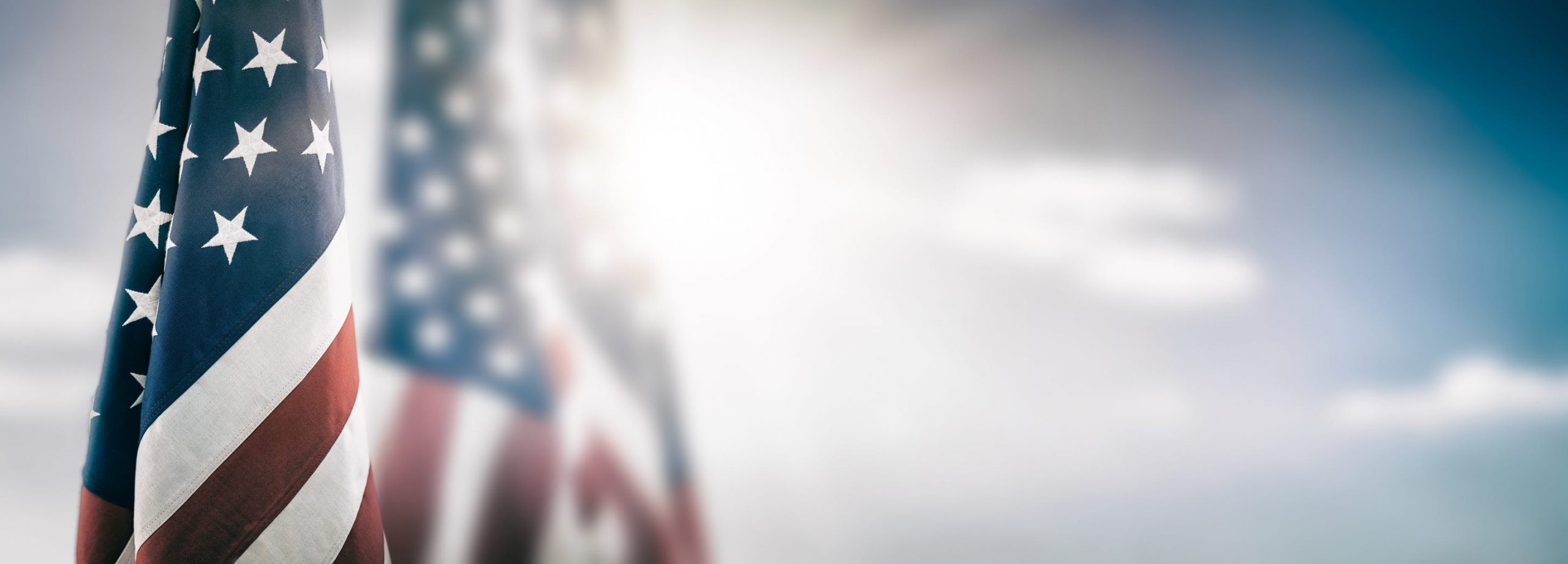
Just as we got ready for Passover, Easter, Ramadan and Norwuz, the Gallup organization raised eyebrows finding that fewer than half of Americans now belong to a house of worship, a downward trend that has persisted for some time. Gallup: Fewer than half of Americans belong to a church or other house of worship (religionnews.com) At the same time, there seems to be concern among the “nones” (i.e. those who have no religious affiliation), that as organized religion decreases, they had better watch out because they will face more and more legal oppression. This position is forcefully articulated by a young law professor named Tyler Broker. The Legal Oppression Of Nonbelievers Will Escalate The More Religion Declines | Above the Law
Well now. Hopefully this view is overly pessimistic while others see interesting possibilities for the nation’s religious future.
Wesley Graham-Michaelson, the former general secretary of the Reformed Church in America, has this to say about the Gallup poll:
“When nones are asked why they have disaffiliated from any religious organization, only 22% say it is because they do not believe in God. The primary challenge facing pastors, rabbis and imams is how to invite nonmembers into an authentic experience of God.” Behind Gallup’s portrait of church decline (religionnews.com)
And he notes that “color” and national origin matter:
“The nones who enjoy lattes at downtown coffee shops on Sunday mornings instead of singing in church are largely young, hip and white. But the country’s demographic future as a whole is becoming more racially and ethnically diverse, and this will impact the religious landscape.”
Lampooning aside, this is probably true in our Tysons community. The vibrant Korean-American churches you can find on our Tysons Interfaith map support the author’s point that immigration can actually increase religious participation. “Denominations rooted in Africa and Asia now have hundreds of congregations throughout the U.S., which continue to grow.”
The task, therefore, for faith communities in this changing world, seems to be to find ways to engage with non-affiliated “nones” to communicate that they are welcome, that the faith experience is relevant and has something to offer their lives. At the same time, we must reassure the non-practicing that faith communities such as those who are members of Tysons Interfaith, are strong supporters of all aspects of the First Amendment. Any perception of state sponsorship of religion is directly counter to the freedom to practice religion (or be agnostic). Admittedly it is tricky to juggle all the requirements of the First Amendment – to protect religious expression without crossing the line into perceived partiality for or even state sponsorship of religion. We can say, that at Tysons Interfaith, we are all about defending the freedom to exercise our various religious practices, while at the same time promoting spirituality, building community and cultivating respect and understanding among neighbors regardless of religious affiliation, race or culture.
This blog post is the expressed opinion of its writer and does not necessarily reflect the views of Tysons Interfaith or its members.
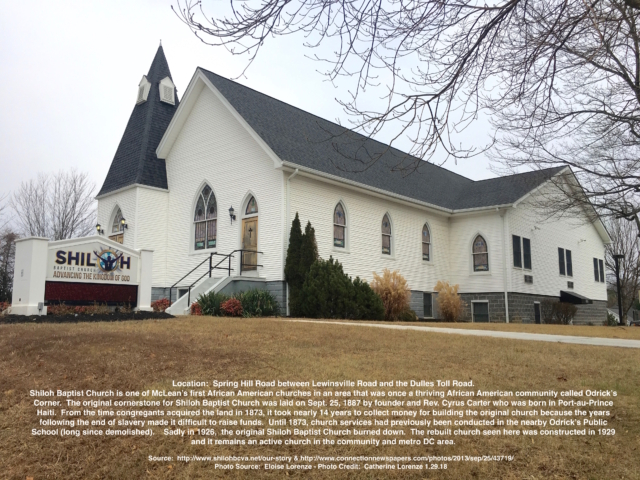
As Spring unfolds, the pandemic recedes, and it seems like we all can breathe just a little bit better again, our nation continues to reel from the storm winds of racial injustice.
Just last weekend, for example, at a special convention of the Episcopal Diocese of Virginia to which I am a delegate, we came oh so close to to allocating $1,000,000 from diocesan investment assets for “Reparations & Undoing White Supremacy.” While many Episcopal Dioceses around the country are taking similar steps, to my personal disappointment, our resolution failed to pass this time around. Our Bishop had this to say about it: “Budget Resolution 4 is bold in scope and strong in intent, “said Bishop Goff. “In coming months, I look forward to working with groups in our Diocese to identify sources of funding and achieve greater clarity about how funding would be used. God bless us as we explore and act together.” Read more here. To read more about the national Episcopal Church’s work for racial healing, you can visit here.
Closer to home, I’ve been thinking about how Tysons could somehow, even in a small way, contribute to the conversation. Bear with me as I tell you about how our neighborhood has a rich African American history that rivals old man Tyson’s.
Just down the road from Tysons is Odrick’s Corner. (Well, the sign painters take the apostrophe out most of the time.)
Who was this dude with the unusual name? Turns out he was a carpenter who lived in Herndon, and he was a freed slave who in the era of Jim Crow managed to save enough money to buy thirty acres of land at the corner of Lewinsville and Spring Hill Roads and build a schoolhouse for African American children and a church, now Shiloh Baptist, a member of Tysons Interfaith! You can find the original gravestones behind the McLean Hamlet residential subdivision. Additional photos here.
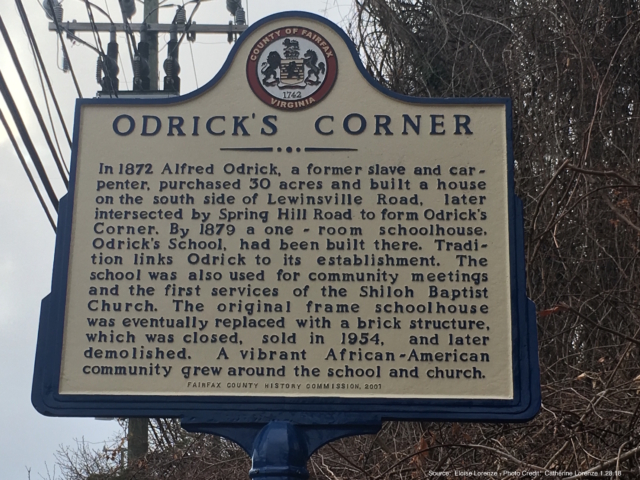
And up Lewinsville Road toward my church you can find a small architectural and spiritual wonder in the form of Historic Pleasant Grove, a Methodist church also built by skilled African American carpenters. It is now a museum and meeting space. I recommend you learn about its history and special events and the wonderful folks whose ancestors are buried in the well-kept graves. Additional photos here.
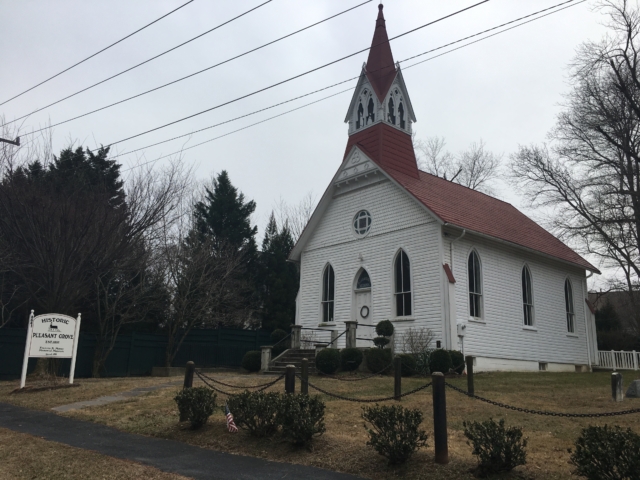
And then there’s the First Baptist Church of Chesterbrook McLean, which vies with Shiloh Baptist as being the oldest African American church in the area. Oldest Black Church in Fairfax Recalls Roots. I met the former pastor and mother of the current pastor at a Share of McLean meeting a few years ago. She grew up on Ball’s Hill Road and told me that whenever it rained, she would have to get out of the school bus at Scott’s Run, now the McLean Metro stop, and use a stick to see how deep the water was on Chain Bridge Road before the driver could proceed to take her home!
So, when you walk or ride around Tysons, think about those African American roots. And then there’s those Native Americans…but that’s another story.
This blog post is the expressed opinion of its writer and does not necessarily reflect the views of Tysons Interfaith or its members.
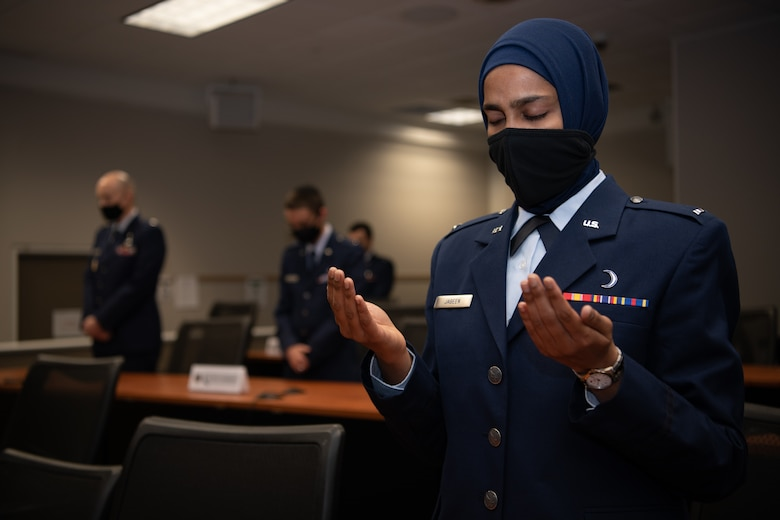
By: John Fairfield, Lieutenant General USAF (Retired)
(Air Force photo by Airman 1st Class Jackson Manske)
In February, 1st Lt. Saleha Jabeen became the U.S. military’s first female Muslim chaplain, graduating from the Air Force Basic Chaplain Course at Maxwell Air Force Base.
The following is extracted from an Air Force article about her: https://www.af.mil/News/Article-Display/Article/2506448/first-female-muslim-chaplain-graduates-from-air-force-chaplain-corps-college/
Jabeen, a native of India, said she was grateful for the opportunity and aware of the responsibility she has to set an example and show that there is a place in the military for anyone who wants to serve.
“I did not have to compromise on any of my religious beliefs or convictions,” Jabeen said. “I am surrounded with people who respect me and are willing to receive what I bring to the table as a woman, a faith leader, and an immigrant. I am provided with numerous opportunities to learn and develop skills that best equip me to be a successful officer and a chaplain in a pluralistic environment. I get to provide spiritual care to all service members, guardians and families and advise the commanders on religious and moral matters regardless of my faith, ethnicity or gender. Like our boss says, it has never been a better time to serve as a chaplain in the U.S. Air Force Chaplain Corps.”
Jabeen is passionate about her role as a chaplain and takes her duty as a spiritual mentor seriously.
“We all have a purpose that is specifically meant for us to fulfill,” Jabeen said. “We must listen to our heart and follow our conviction. It is important to have people in our lives who model that for us. Choose that kind of mentorship and choose good companionship. I just want people to remember that God, or higher power or the values that people uphold, remind us that we are all created with a plan: to become the best versions of ourselves. There is a ‘why’ for our existence and ultimately it is meant for us to be the best versions of ourselves. Commit to it, accomplish it and uplift others to do the same. Do all that needs to be done with kindness, generosity, resilience and the grit to never quit.”
We congratulate Lieutenant Jabeen and salute her for her service.
Won’t it be nice when we will not have to use the word “first” when considering gender, religion, or race?
This blog post is the expressed opinion of its writer and does not necessarily reflect the views of Tysons Interfaith or its members.
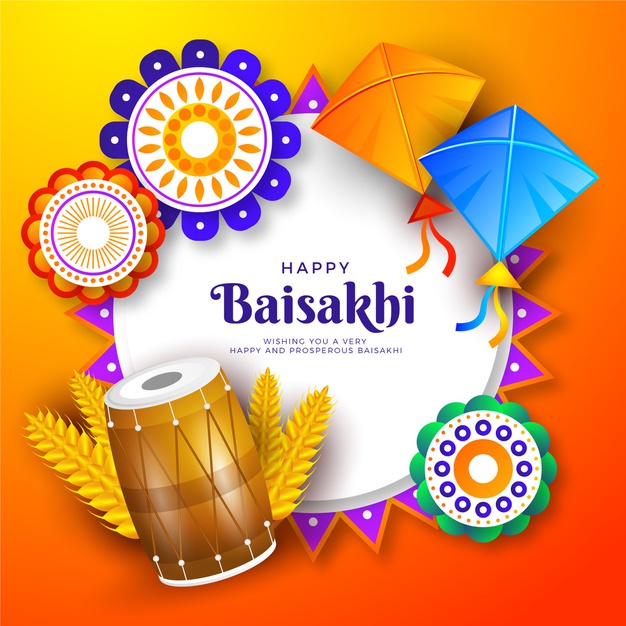
Just about every spiritual path celebrates spring in a special way. For those of us who follow the Sikh way of life, in spring, we celebrate our most auspicious holiday, called Baisakhi. This year, Baisakhi is celebrated on April 13th.
The Sikh way of life was established by ten successive Sikh Gurus in India. Each of them was a pure channel of God’s love and wisdom. They inspired people to live lives of devotion, service and joy – to live in God-consciousness. “Sikh” means “student of Truth.” Guru Gobind Singh Ji was the tenth Sikh Guru in human form.
In mid-April, 1699, at the spring festival called Baisakhi, Guru Gobind Singh Ji initiated a special baptism of the most devoted Sikhs, in which he prepared and served a divine nectar called Amrit. Through this baptism, the deeply devoted Sikhs became Khalsa, or pure ones. After the Guru baptized the first five Khalsa, he had them baptize him as well. Guru Gobind Singh Ji declared that whenever five Khalsa gather in his name, he would be there with them.
Baisakhi is the highest celebration for Sikhs. It is a time of rededication and renewal of our faith. Many people take part in this special baptism to become Khalsa at this blessed time of year.
This blog post is the expressed opinion of its writer and does not necessarily reflect the views of Tysons Interfaith or its members.
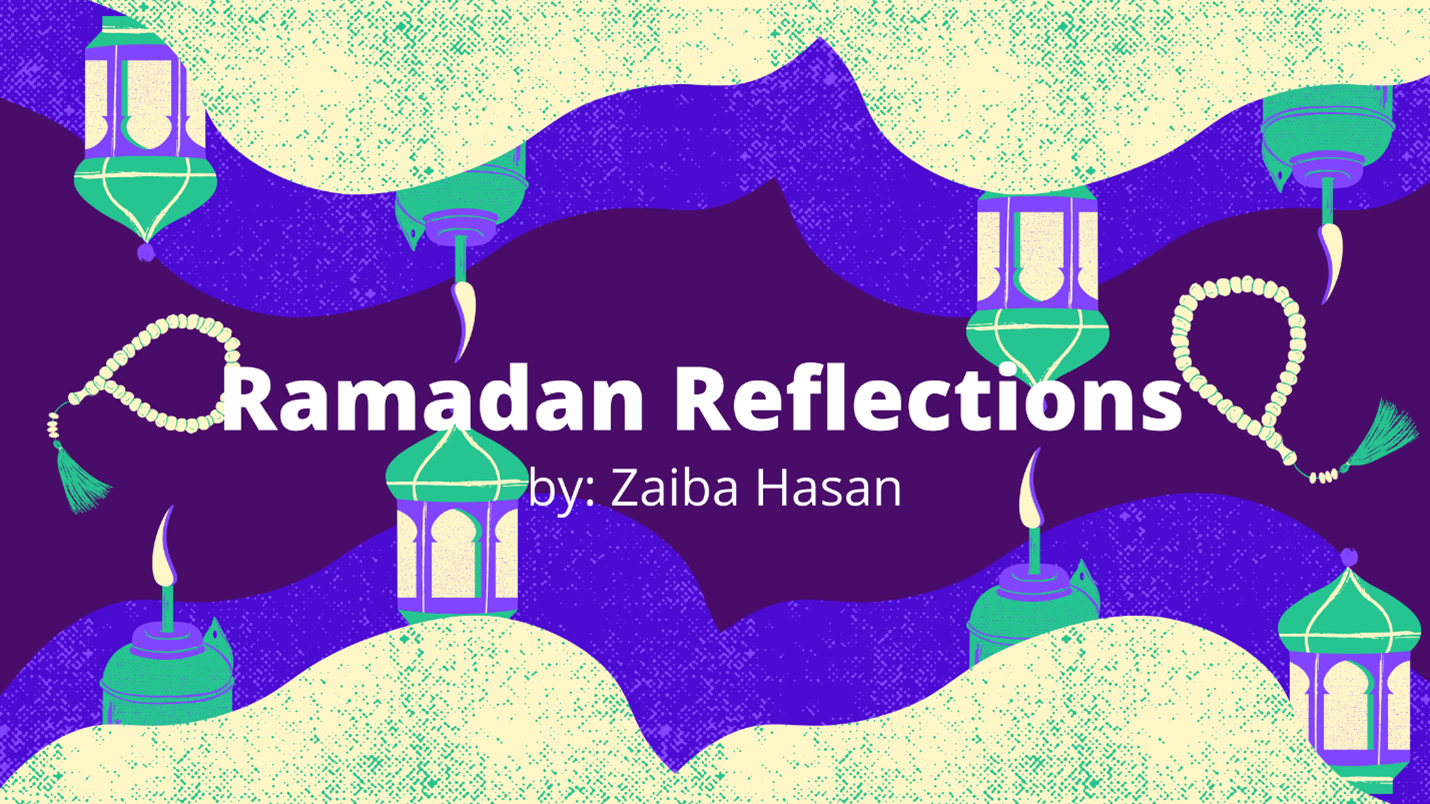
Monday, April 12th, 2021 marks the ninth month in the Islamic calendar when for thirty days, over 3.5 million American Muslims will fast and “yes, even forego water.” Ramadan for Muslims world-wide not only is one of our five pillars[1] or religious tenets, it is also an opportunity to reset, renew, and rejuvenate your spiritual connection to God (Allah) and use the physical pangs of abstinence, hunger, thirst during the daylight[2] hours as a tangible reminder of your spiritual connection to something bigger than your body’s physical needs. However, as a religious minority it is often harder for us to do this. Living in a non-Muslim community means that we are squeezing in prayers between work meetings, breaking your fast at your son’s baseball games, or “listening” to the Quran[3], at stoplights while rushing to your next appointment. Not necessarily conducive to that whole spiritual awakening we are supposed to be experiencing. For our family, knowing that we cannot stop our every-day lives to dedicate it solely to religious practices, we try to fit in the intent behind Ramadan in a more practical application whenever we can.
Charity: As one of the main five tenets fitting in additional charitable efforts during this month can be a welcomed experience to all. After supporting our local Mosque, our family usually chooses a few charities to support either financially or with our physical time. In volunteering we are taking the meaning behind this month of connection to reconnect with ourselves as a family and to connect with the community as well. (Note: we are supporting St. Jude Children’s Research Hospital and you all are invited to our virtual iftar.)
Interfaith: My personal philosophy has always been that we are more alike than different, and in celebrating our differences we can view them as a rich opportunity for learning and growth. We are bridging that gap of misunderstanding one smile, one greeting at a time and potentially creating a village of allies that we all need during these rocky times. Use this month as an opportunity to take a treat to your neighbor, read a Ramadan book to your child’s class, write a blog in your local community. Make our presence known because it is a lot harder to hate when there is a person sharing their samosas with you.
Reflection: In using the momentum of Ramadan as a springboard to further reflection. How can we continue doing good works for a local community? How can we make small changes of understanding to further close the gap of misunderstanding? How can we as a family come together and with our own hands help the hungry, care for our neighbor, reconnect with God (Allah) in a way that is more meaningful than rushed prayers in between activities?
Maybe celebrating Ramadan here is not as easy as it would be in a Muslim country. However, I would argue that it is more meaningful. We as a Muslim community must work that much harder to implement and institute our religious traditions in a non-Muslim country. In making space for ourselves now, we are also making space for others that come behind us. If that is not in the spirit of Ramadan than I don’t know what else is.
Until Next Time,
This blog post is the expressed opinion of its writer and does not necessarily reflect the views of Tysons Interfaith or its members.
[1] Shahada (profession of faith), Salat (prayer), Zakat (charity), Saum (Fasting), Hajj (pilgrimage)
[2] Muslims refrain from food, water, and sexual relations from sunrise to sunset.
[3] Muslims holy text
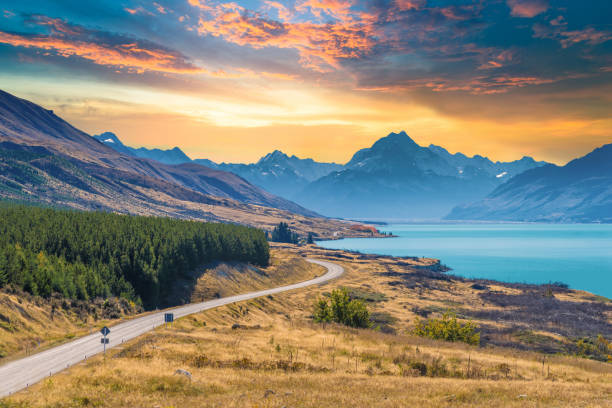
In a recent Lenten reflection session at St. Thomas Episcopal, we talked about prayer, using as our starting point the Lord’s Prayer, which is well-known even in our secular culture.
Noting how reciting the same words over and over can become stale, one person shared how they had been deeply moved when they used an alternate version that can be found in the New Zealand Prayer Book. https://anglicanprayerbook.nz/167.
The new translation forced them to focus on the meaning of the original text. Looking up this version, I was also struck by how the non-traditional perspective adds power and universality to the prayer, and I commend it to you.
“Eternal Spirit, Earth-maker, Pain-bearer, Life-giver,
Source of all that is and that shall be,
Father and Mother of us all,
Loving God, in whom is heaven:
The hallowing of your name echo through the universe!
The way of your justice be followed by the peoples of the world!
Your heavenly will be done by all created beings!
Your commonwealth of peace and freedom sustain our hope and come on earth.
With the bread we need for today, feed us.
In the hurts we absorb from one another, forgive us.
In times of temptation and test, strengthen us.
From trials too great to endure, spare us.
From the grip of all that is evil, free us.
For you reign in the glory of the power that is love,
now and forever. Amen.”
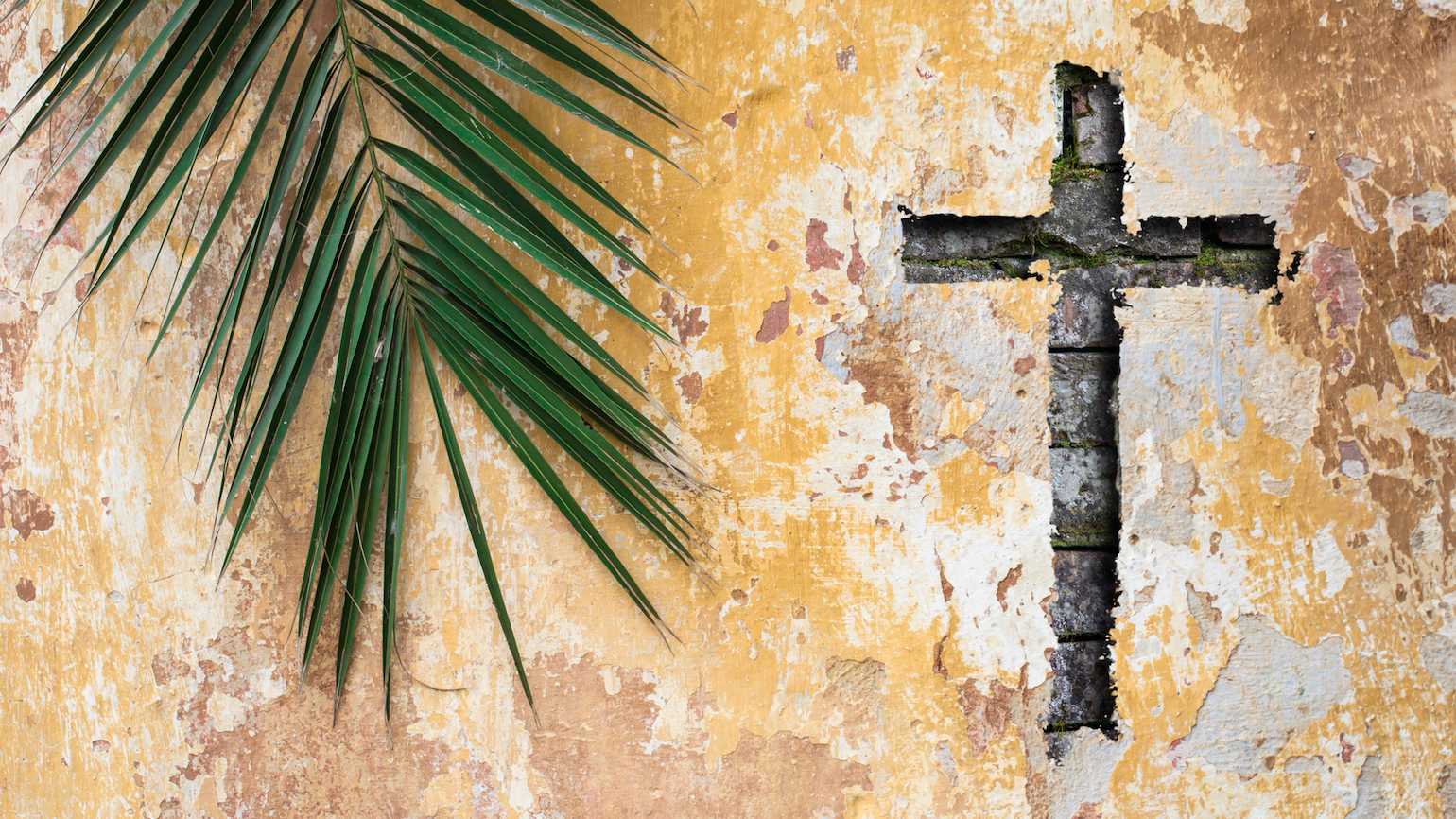
For Christians, we are about to enter the holiest week of the Christian year, aptly known as Holy Week. During Holy Week, Christians mark the events that took place in the last week of Jesus’ life. We begin with his triumphal entry into Jerusalem at the head of a peasant parade hailing his arrival. As the week progresses, we gather with Jesus and his disciples for the meal commonly known as the Last Supper. We watch in horror as Jesus is betrayed, arrested, tortured and then crucified. We sit in anguish with his friends in the midst of their shock and horror at Jesus’ death. And finally, we celebrate the miracle of resurrection and new life at the empty tomb on Easter Sunday.
We begin on Palm Sunday (March 28th, this year). On Palm Sunday, we remember Jesus’ return to Jerusalem. John Dominic Crossan and Marcus Borg have described Palm Sunday as a day of two processions. They write:
One was a peasant procession, the other an imperial procession. From the east, Jesus road a donkey down the Mount of Olives, cheered by his followers. Jesus was from the peasant village of Nazareth, his message was about the kingdom of God, and his followers came from the peasant class. They had journeyed to Jerusalem from Galilee, about a hundred miles to the north, a journey that is the central section and the central dynamic of Mark’s gospel. Mark’s story of Jesus and the kingdom of God has been aiming for Jerusalem, pointing toward Jerusalem. It has now arrived. On the opposite side of the city, from the west, Pontius Pilate, the Roman governor of Idumea, Judea, and Samaria, entered Jerusalem at the head of a column of imperial cavalry and soldiers. Jesus’s procession proclaimed the kingdom of God; Pilate’s proclaimed the power of empire. The two processions embody the central conflict of the week that led to Jesus’ crucifixion. [1]
Pre-pandemic, many churches distribute palm branches to those who gather for worship. We wave our palm branches and declare, “Hosanna! Blessed is the one who comes in the name of the Lord.” This year, in the midst of the ongoing pandemic, churches are worshiping in a variety of ways. At St. Thomas, we’ll gather outside on Saturday evening and over Zoom on Sunday morning. Parishioners have been invited to pick up palm branches at church before the Sunday morning service.
In our individual devotions during Holy Week, many Christians read from John’s Gospel about the events that happen after Jesus’ triumphal entry. On Monday, we read John 11: 1-12. On Tuesday, we read John 12: 20-36. And on Wednesday, we read John 13: 21-32.
This brings us to Maundy Thursday (this year, April 1). Maundy Thursday remembers the last supper that Jesus ate with his friends before his death. The day gets its name from the Latin word mandatum or mandate. It comes from Jesus’ command (mandate) that his followers, “love one another as I have loved you.” You can read the whole of the Maundy Thursday story here.
One of the key moments on Maundy Thursday is when Jesus does something quite unexpected for a great teacher. Before Jesus and his companions gather to eat, Jesus wraps a towel around his waist and washes his disciples’ feet. Normally this task would have been done by a servant. Instead, Jesus humbles himself to take on this role – and teaches every Christian the key role that service to others plays in the Christian life.
Good Friday (this year, April 2) remembers the day that Jesus was crucified. It’s probably the most somber day in the Christian year. It seems counterintuitive to call a day that was filled with torture, suffering and death “good.” But Christians believe that Jesus’ death on the cross is ultimately a repudiation of death, evil, and sin. Worship on this day is somber and reflective. We pray. We contemplate the cross. And we share in the sorrow of Jesus’ death (even as we know what his first followers did not – that resurrection is coming).
On Holy Saturday morning (this year, April 3), Christians sit with the grief of Jesus’ death. Again, we know that Resurrection is coming, but has not yet arrived. Many Christians read of Jesus burial by Joseph of Arimathea in Matthew’s Gospel.
As the sun sets on Holy Saturday, Christians gather for what is known as the Great Vigil of Easter. From the earliest days of the Christian Church, Christians would gather in the dark on the night before Easter. A new fire is kindled, and an ancient hymn called the Exsultet, which sings of God’s glory would be sung. They would tell the stories of God’s saving acts in history – how God has always acted for justice and new life. Those who have been preparing for baptism were baptized. And as the sun rose on Easter morning, the first call and response of, “Alleluia, the Lord is risen! The Lord is risen indeed, Alleluia!” is heard. Most churches that celebrate an Easter Vigil now, begin at sunset, though I have participated in an Easter vigil that began in the dark at 4am on Easter Sunday.
Finally, on Easter Sunday (this year, April 4), we celebrate the unthinkable news that Jesus has been raised from the dead. Each of the Gospels (Matthew, Mark, Luke and John) tells the story a little differently, but they share remarkable consistency. And while there was no video camera to tell the story of how the resurrection occurred, we can see its truth in the transformation of Jesus’ first followers. In the coming days and weeks, they’ll undergo a profound transformation. They move from being frightened deniers of Jesus (like Peter after Jesus arrest) who are afraid and locked away (see John 20: 19-31) to fearless evangelists for the way of Jesus Christ (see Acts 2: 1-21).
The span of these eight days that stretch from Palm Sunday to Easter Sunday are truly my favorite days of the Christian year. In them, we walk a road that includes hope, community, betrayal, death and new life. If you’d like to learn more or experience one or more of these services, you are welcome to join us at St. Thomas Episcopal Church in McLean (via Zoom – links will be on our website on Monday March 29) or any of the Christian churches that are part of Tysons Interfaith. Click on the logos here to be connected to the congregation’s website.
.
[1] Marcus Borg and John Dominic Crossan, The Last Week: What the Gospels Really Teach About Jesus’s Final Days in Jerusalem (New York: HarperCollins, 2006), pp. 2-3.
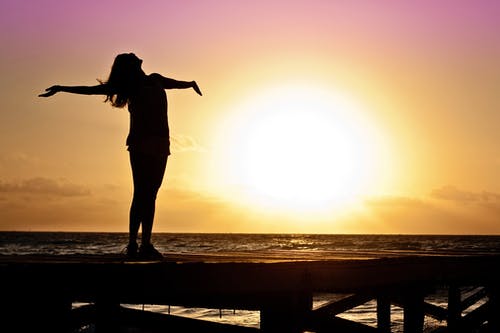
In our Torah (the scroll with the first five books of the Bible penned by hand in Hebrew), one of the most important ideas is freedom. This includes the story of Passover, which begins in ancient times with Abraham, the first person to have the idea that maybe all of those little statues his contemporaries worshipped as gods were just statues. The idea of one God, invisible and all-powerful, inspired him to leave his family and begin a new people in Canaan, the land that would one day bare his grandson Jacob’s adopted name, Israel.
God made a promise to Abraham that his family would become a great nation, but this promise came with a frightening vision of the troubles along the way. “Your descendants will dwell for a time in a land that is not their own, and they will be enslaved and afflicted for four hundred years, however, I will punish the nation that enslaved them, and afterwards they shall leave with great wealth.”
In the years our ancestors lived in Egypt, our numbers grew, and soon the family of Jacob became the People of Israel. Pharaoh and the leaders of Egypt grew alarmed by this great nation growing within their borders, so they enslaved the Israelites. The Israelites were forced to perform backbreaking labor. The Egyptians feared that even as slaves, the Israelites might grow strong and rebel. So Pharaoh decreed that Israelite baby boys should be drowned to prevent Israelites from overthrowing those who had enslaved them.
But God heard the cries of the Israelites. God then sent upon the country that enslaved them ten devastating plagues, afflicting and destroying everything from their livestock to their crops.
At the stroke of midnight on 15 Nissan 2448 BCE, God released the last of the ten plagues, the killing of the firstborn. While doing so, God spared the children of Israel, “passing over” their homes, hence the name of the holiday.
Pharaoh’s resistance was broken, and he virtually chased his former slaves out of the land. The Israelites left in such a hurry that the bread they had baked as provisions for the way did not have time to rise. Hundreds of thousands of Israelites- men, women and children, were freed from slavery that day, and began their trek to Mount Sinai.
The Jewish holiday of Passover celebrates the liberation of the Israelites from Egyptian Slavery. Jews around the world celebrate this traditional eight day holiday every year. We have first and second night Seders. We eat Matzo instead of bread. We have first night and last night worship services.
The Hagaddah (Order of the Passover Seder) tells the story of our freedom. The Haggadah tells about how the Jewish people were slaves and then became free. Everyone at the table takes part in the Seder. Children are an integral part of the experience, bridging children and the adults who can bring a unique perspective to any Seder, as each year they participate with fresh eyes. Young people are still questioning, struggling, and wrestling with the themes that we experience during Passover as they contemplate their own journey toward adulthood. Adults question these themes as well, and many times write their own Seders to enhance and update their beliefs and add in current themes of freedom.
It is a mitzvah (commandment) to re-live this dramatic event, the emergence of the Israelites from slavery to freedom. Passover also opens each of us up to questions of freedom today. We discuss those who still are not free and how we might help them in their struggles. What WE can do to support those who are still not free- emotionally, physically… or otherwise.
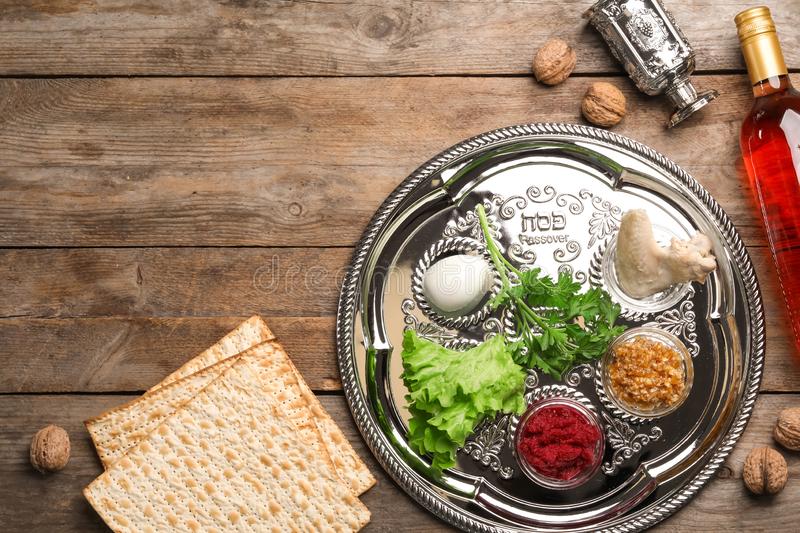
In preparation for the holiday, Jews are commanded to rid their homes of leavened foods-including breads, rolls, bagels, cereals, pastas etc. It is traditional to donate unopened boxes of these foods to those who are hungry. Our congregation hosts a food drive every year collecting for area food banks.
Each year, all over the world, Passover is recalled with the ritual meal where participants of all ages read from a Haggadah. The Hagaddah (Order of the Passover Seder) tells the story of our freedom. The Haggadah tells about how the Jewish people were slaves and then became free. We may use different Haggadahs. Some may have finger puppets and guitars around the table, and some may use Haggadahs that came with Maxwell House Coffee forty years ago. Some read from new Women’s Hagaddahs and some from 21st century updated inclusive Haggadahs with new language and ideas. And some write their own that are just right for those coming to their Seders. Whatever Hagaddah is used, the basic story and many songs and prayers remain the same. The Hagaddah, the story of Passover is our script. We learn the customs, taste the foods, and retell the moments of this dramatic story that concludes in celebration after crossing through the Red Sea.
We begin the Seder by singing about how good and pleasant it is to dwell together. This year same as last year, many of us will still be getting together over Zoom with family and friends and will be calling these gatherings Z’eders as we are still socially distancing due to the COVID pandemic.
We continue, lighting the festival candles with a special blessing-praising God, the candles remind us we must help and not hurt, cause joy and not sorrow, create and not destroy, and help all to be free. We praise God for the gift of Life.
Many Seder meals begin with Matzo Ball Soup, Gefilte Fish, a Hard-Boiled Egg in Salt Water (to remember the tears that were shed, and the egg to signify new beginnings, before the actual meal begins.
A Seder Plate in the center of the table includes ritual symbols of the holiday. These include a roasted lamb shank bone representing the Pesach sacrifice at the Temple in Jerusalem, recalling the ancient sacrifice of a paschal lamb in the Temple, bitter herbs/horseradish representing the bitterness of slavery, a roasted egg -symbolizing part of the sacrifice in the Temple in Jerusalem, charoset (apples nuts, cinnamon, honey and wine mixture)- representing the mortar and brick used by the slaves, Parsley- representing hope and renewal- this is dipped into saltwater to represent tears, again a symbolic reminder of the pain felt by the Israelites when they were enslaved. Unleavened bread called matzo is served in lieu of bread or rolls, honoring the bread that the Israelites took with them when they left slavery so quickly that it didn’t have time to rise.
We are commanded to eat matzo in lieu of leavened breads, bagels, muffins, rolls, pasta, etc. for the entire eight days of Passover. There are lots of fun recipes to make meals and snacks including chocolate dipped matzo, caramel toffee matzo, matzo pizza, matzo lasagna etc. The “middle matzo” on the table is usually hidden during the meal, for the children to find after the meal. It’s called the Afikomen. Whoever finds it, gets a prize!
- That God will Free us from the burdens of slavery.
- Deliver us from bondage.
- Redeem us with an outstretched arm.
- And Take us as God’s people.
Two thirds of the story of Passover is shared before the meal is served, with the remainder following the meal and closing with songs and laughter.
If the meal is to be “Kosher for Passover style” it is usually an all dairy, or all meat, meal. Regardless of whether the hosts keep kosher otherwise, meat and dairy are traditionally not offered during the same meal.
Traditionally, the first night Seder is celebrated in one’s home, and the second night Seder is more of a community Seder either at a synagogue, community center, or other larger gathering place. Again, our second night Seder will be online this year.
It is traditional to open one’s home up to those who have never been to a Seder, or have nowhere else to go for Seder, if you have room at your table.
Our temple (or Synagogue) is offering several activities during this eight-night holiday, including services, cooking classes, craft projects, a concert and weekday daily programing by our clergy.
For more information, please see our website www.templerodefshalom.org
Our Temple Rodef Shalom community wishes all who celebrate a “Zissen Pesach” (Joyful and Sweet Passover) and hope that this explanation is helpful to those who are not familiar with this holiday.
